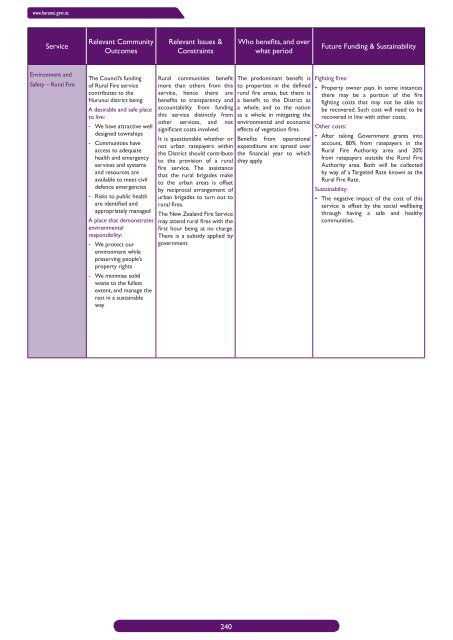Long Term Community Plan 2012-2022 - Hurunui District Council
Long Term Community Plan 2012-2022 - Hurunui District Council
Long Term Community Plan 2012-2022 - Hurunui District Council
Create successful ePaper yourself
Turn your PDF publications into a flip-book with our unique Google optimized e-Paper software.
www.hurunui.govt.nz<br />
Service<br />
Relevant <strong>Community</strong><br />
Outcomes<br />
Relevant Issues &<br />
Constraints<br />
Who benefits, and over<br />
what period<br />
Future Funding & Sustainability<br />
Environment and<br />
Safety – Rural Fire<br />
The <strong>Council</strong>’s funding<br />
of Rural Fire service<br />
contributes to the<br />
<strong>Hurunui</strong> district being:<br />
A desirable and safe place<br />
to live:<br />
- We have attractive well<br />
designed townships<br />
- Communities have<br />
access to adequate<br />
health and emergency<br />
services and systems<br />
and resources are<br />
available to meet civil<br />
defence emergencies<br />
- Risks to public health<br />
are identified and<br />
appropriately managed<br />
A place that demonstrates<br />
environmental<br />
responsibility:<br />
- We protect our<br />
environment while<br />
preserving people’s<br />
property rights<br />
- We minimise solid<br />
waste to the fullest<br />
extent, and manage the<br />
rest in a sustainable<br />
way<br />
Rural communities benefit<br />
more than others from this<br />
service, hence there are<br />
benefits to transparency and<br />
accountability from funding<br />
this service distinctly from<br />
other services, and not<br />
significant costs involved.<br />
It is questionable whether or<br />
not urban ratepayers within<br />
the <strong>District</strong> should contribute<br />
to the provision of a rural<br />
fire service. The assistance<br />
that the rural brigades make<br />
to the urban areas is offset<br />
by reciprocal arrangement of<br />
urban brigades to turn out to<br />
rural fires.<br />
The New Zealand Fire Service<br />
may attend rural fires with the<br />
first hour being at no charge.<br />
There is a subsidy applied by<br />
government.<br />
The predominant benefit is<br />
to properties in the defined<br />
rural fire areas, but there is<br />
a benefit to the <strong>District</strong> as<br />
a whole, and to the nation<br />
as a whole in mitigating the<br />
environmental and economic<br />
effects of vegetation fires.<br />
Benefits from operational<br />
expenditure are spread over<br />
the financial year to which<br />
they apply.<br />
Fighting fires:<br />
• Property owner pays. In some instances<br />
there may be a portion of the fire<br />
fighting costs that may not be able to<br />
be recovered. Such cost will need to be<br />
recovered in line with other costs.<br />
Other costs:<br />
• After taking Government grants into<br />
account, 80% from ratepayers in the<br />
Rural Fire Authority area and 20%<br />
from ratepayers outside the Rural Fire<br />
Authority area. Both will be collected<br />
by way of a Targeted Rate known as the<br />
Rural Fire Rate.<br />
Sustainability:<br />
• The negative impact of the cost of this<br />
service is offset by the social wellbeing<br />
through having a safe and healthy<br />
communities.<br />
240

















